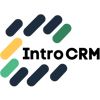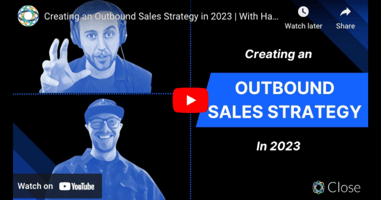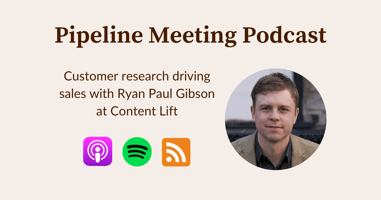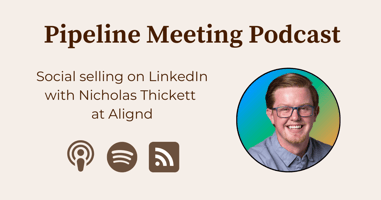The sales landscape is constantly evolving. So what can sales teams do to evolve their outbound...
Community-led growth marketing with Connie Lund at testRigor
Connie Lund is a marketer who espouses the benefits of community-led growth marketing, driving 4x ROI on campaigns and filling the sales funnel for her sales team.
Show Description
A sales-oriented marketing podcast for B2B marketers. Learn from short interviews published every week.
Hit play and subscribe today if you want to follow the latest trends in revops, demand gen, lead gen, and sales enablement.
Subscribe
Popular Platforms
Apple Podcasts
Spotify
RSS Feed
Also available:
Amazon • Anghami • Castbox • Castro • Deezer • GoodPods • Google Podcasts • iHeart Radio • Overcast • Pandora • PlayerFM • Pocket Casts • Podcast Index • Podchaser • Stitcher • TuneIn
Show Notes
Connie Lund is a marketer who espouses the benefits of community-led growth marketing, driving 4x ROI on campaigns and filling the sales funnel for her sales team.
She talks about specific webinars, events, and other tactics she has used, and compares/contrasts them with more conventional marketing tactics.
Connie outlines how B2B marketers can apply these tactics and set their sales teams up for success.
Find Connie Lund on LinkedIn: https://www.linkedin.com/in/bensenc/
Learn more about testRigor: https://testrigor.com/
Transcript
[00:00:00] Intro
[00:00:00] Harris Kenny: Welcome to Pipeline Meeting where marketers come to talk about sales. I'm your host Harris, Kenny, and I'll be joined by guest every Monday and Wednesday for brief 15 minute interviews where we'll share tips that you can apply to support your sales team and help them close more deals.
[00:00:15] Harris Kenny: You don't have time to listen to this whole episode, you can skip ahead in the show notes in your podcast player, or find the transcript at introcrm.com/podcast. All the episodes are published there.
[00:00:28] Marketing as community building
[00:00:28] Connie Lund: What I'm talking about when I say community led means that everything I do from a marketing perspective is about community building. I'm not bringing man into one platform, but it's a common thing with a common need.
[00:00:45] Connie Lund: Some people might say, that's just marketing. Okay, fine. My last webinar, I hit 834 people register and the follow up emails, most of my emails on average have a 20% open rate, but those follow up emails, all three of 'em had a 40% open rate.
[00:01:08] Connie Lund: That's engagement. People think I'm a little crazy about engagement, but you need engagement for marketing to work. Has nothing to do with how much you spend.
[00:01:19] Connie Lund: The title of that webinar was the thing, just like the email subject lines are the thing, it was the ROI of no code test automation. So it was something that really people liked. Anyway, that's how I view it and community led means for me literally, is that you are trying to build this community and pulling people in to get them gathered around something.
[00:01:51] Connie Lund: And then another example is, these brands are flat, like they're there, right? They got a website and they're flat. I like to bring a vibrancy and actually make them more human.
[00:02:04] Connie Lund: A test trigger every other week we had a half hour. Virtual session, very technical, very focused. I find that technical people will be all over the very focused topic, and people could come and participate and ask questions. Our customers could come and ask questions, and then we record them. This is really simple. Make a resource library of all these topics and people can look at the past ones.
[00:02:36] Connie Lund: That's providing them with something that gets their attention or however I get their attention, then they can come and participate and anticipate the next one.
[00:02:49] Connie Lund: Then I create a newsletter and I send out the topics for the next ones.
[00:02:53] Connie Lund: In HubSpot, going back to my attribution, half of the deals were associated with that and $127,000 revenue. There's not a huge budget to run a Zoom meeting.
[00:03:07] Connie Lund: What I'm saying is that there's no huge spend on that which makes the ROI really great, like four x.
[00:03:16] Valuable marketing spend
[00:03:16] Connie Lund: The one good place for spend is that there's lists, people have built lists out online and they rank pretty much first page of Google search. Those companies are like media companies. They charge for the placement and more to be number one.
[00:03:32] Connie Lund: And so those placements we had about four. I always set up UTM tracking code and HubSpot so that we could track all of that. But they were doing okay. They were doing just as good as Google ads. And the cost difference is huge.
[00:03:48] Connie Lund: So that's my view on getting started, that it doesn't take a big budget. You should be building content, you should be building resources around what you offer. And it's not expensive at all. But it does take time and effort and thought, right? That's the difference I think is instead of just spending money, you actually have to put time and thought into it and be there like show up.
[00:04:14] Sales with PLG
[00:04:14] Harris Kenny: And how does that affect sales? So if a company that's doing this type of growth motion, where they're engaging more with the community and doing webinars and getting the types of open rates that you were talking about in those post follow ups. ,does that change how a salesperson would engage with those prospects or how a salesperson would be doing prospecting.
[00:04:32] Connie Lund: The one thing for sure, and this is really captain obvious, the free version, I had nurturing emails, going to them with links to try to help them, and those people, a fraction of those will convert. And we had those emails going out in our salesperson's name, right? The nurturing emails.
[00:04:52] Connie Lund: They weren't coming from marketing, they were coming from her. And so people would hit reply and they would talk to her in sales directly and she's like, oh, Connie, another one came today. And they said, I've done it. I've tried it. I'm ready to buy. How much does this cost? Whatever.
[00:05:08] Connie Lund: The conversation's totally different. Don't have to start with the education, the demo, and try to convince them. They're converted, they're ready to buy. Completely different, which is cool.
[00:05:21] Harris Kenny: It makes their job a lot easier.
[00:05:23] Connie Lund: Yes, yes. And then the other piece is with the customers. The customers coming to the tips and tricks session every other week.
[00:05:33] Connie Lund: They could invite their coworkers and that groundswell happens and cuz we didn't, you. We didn't care how many people came or who watched or whatever. The upsells were much easier there too because it was their idea. Whenever you have something that's your idea and you need to sell it, it's so much easier if it's their idea.
[00:05:58] Harris Kenny: One question I have on around this type of content, how much of this is like a faith-based exercise where if you build it, they will come.
[00:06:06] Harris Kenny: Because the point of the session is not to sell, sell, sell, sell, sell, right? It's to educate and create value and try to do something that they would wanna take time outta their day to do. Is the challenge, knowing your audience well enough that you can create content where they will connect to the dots themselves?
[00:06:20] Connie Lund: So you're asking, to me it's like, which part of the funnel is it?
[00:06:24] Harris Kenny: Yeah, yeah, yeah. That's a much better way saying it.
[00:06:27] Community in the sales funnel
[00:06:27] Connie Lund: doing, if we were doing podcasts with senior executives, talking about the value, why they could use no code QA tool, that would be more of a door opener.
[00:06:44] Connie Lund: that's more of a high level like, and the person hearing it might go. I had never thought about that, and that could save me hundreds of thousands of dollars.
[00:06:54] Connie Lund: The tips and tricks was specifically around technical aspects of using the tool. And my reasoning is that people who are interested in this are QA people, they're very hands on, right?
[00:07:11] Connie Lund: And so the first path, or was literally to get content built for them. With a bottoms up plan that they would go back to their company and try to sell bottoms up. It is a different place if people are on these lists, then they come in to the website and they can then find these. and browse through them. These are not the mechanism for top of funnel. They're deeper, but they're exploring. Once they're aware of it, they're exploring the tool, exploring the capabilities.
[00:07:46] Connie Lund: And then the other piece I think is most important is when they're talking to somebody, I've felt this way in every company, is that if they can say, Hey, you know, Here's the things that we are doing, you know, essentially for you guys, right?
[00:08:03] Connie Lund: As prospects or customers, you know, we're having these sessions, these technical sessions where you can learn more and ask questions. We're, you know, doing different things. And I just feel like that adds, like I started this with a vibrancy to the brand instead of being flat. We are participating with you, and what kind of things do you want? What topics do you want?
[00:08:28] Connie Lund: I also think that when they come, whether it's a customer or you never knew who it was, but, and they ask questions and get answers directly, I just feel like that builds so much trust and they feel like, wow, this entity, organization, Is participating in this with me.
[00:08:51] Connie Lund: You were asking about the other aspects of the sales.
[00:08:53] Connie Lund: We had SDRs who were going into LinkedIn and outreaching specifically to the icp. What's interesting about that? We did a number of things including, Google ad spend, the lists, organic. It ended up that anything had to go into organic that didn't have attribution.
[00:09:16] Harris Kenny: Yeah. Organic slash other
[00:09:20] Organic vs SDRs
[00:09:20] Connie Lund: Unknown one. But anyway, um, what was interesting looking back at the last six months of deals was that, you know, I, I think the big surprise was to my leader was that it wasn't all coming in from the SDRs, right?
[00:09:37] Harris Kenny: right?
[00:09:37] Connie Lund: So after 10 months, no, it wasn't. The chunk from the SDRs was the same as organic.
[00:09:46] Connie Lund: There was only, you know, one deal from Google ads and a lot of money had been spent on that. And so, you know, um, there were two from lists. So I'm just saying that that literally, um, that's where I think you need to look right, is. Three months, take a look at where are the deals coming from and then adjust, right?
[00:10:18] Connie Lund: Because if something's working, you know, as long as it's scalable, you can do that.
[00:10:23] Harris Kenny: In my mind, if you are taking this approach using community and events and you're asking these questions of yourself and of your customers, I feel like it also is the kind of thing that can put more tailwind behind every other activity because you're asking what are our customers gonna be interested in?
[00:10:38] Harris Kenny: And well, SDRs can use that to write better copy. And you could improve potentially paid ads too, if you're sitting down and just thinking, reflecting and, and sort of bouncing back and forth with customers a little bit, instead of just always being in like broadcast mode of like, we're sending these cold emails, we're running these ads, we're buying these lists.
[00:10:57] Harris Kenny: And you're sort of always pushing out, but you're not necessarily getting tight qualitative feedback, but when you do with these events in community, I feel like it strengthens all those maybe more typical or conventional outreach methods.
[00:11:09] Marketing in a silo
[00:11:09] Connie Lund: It bridges that silo. So as a marketer, the worst thing we can do is go off in a silo, in broadcast mode and, you know, say we're the best tool ever. You know, what, what, um, is allowed for, so every time I would be meet with the, um, with my CEO, he would start thinking and start talking to himself.
[00:11:36] Connie Lund: And it was actually a good mental exercise to think about, what should we highlight? What is new, what hasn't been talked about. It's always the interesting conversations when sales. What? We can do that? Do you know what I mean? Like in small companies, everybody's moving fast.
[00:11:55] Connie Lund: And then after we met in Slack, I'd be getting, oh, put this down to put this topic down too. They have to be planning for a lot of things, but it's a mode of thinking just for marketing.
[00:12:05] Connie Lund: that I think's important, especially when you're taking a very technical tool to market.
[00:12:10] Connie Lund: When you're a small company, it can accomplish so much at scale with minimal effort to try to accomplish all the things like the customer communication, the new feature communication, and then we're also capturing the CEO's view in that one segment that we can put up.
[00:12:29] Connie Lund: It's a good tool. It's a good tool for doing all those things that maybe later, you know, when the company has more people than different people who have parts of those functions.
[00:12:39] Harris Kenny: If people are interested in what you're talking about and interested in how you're talking about community led marketing, where can people find you?
[00:12:44] Connie Lund: At the moment LinkedIn is the best place, connie Lund.
[00:12:49] Outro
[00:12:49] Harris Kenny: That's all for now. You can find show notes at intro crm.com/podcast. The theme music for Pipeline Meeting is by Neighbourhood Vandal. If you learned something, consider sharing this show with a friend. Thanks for listening.



